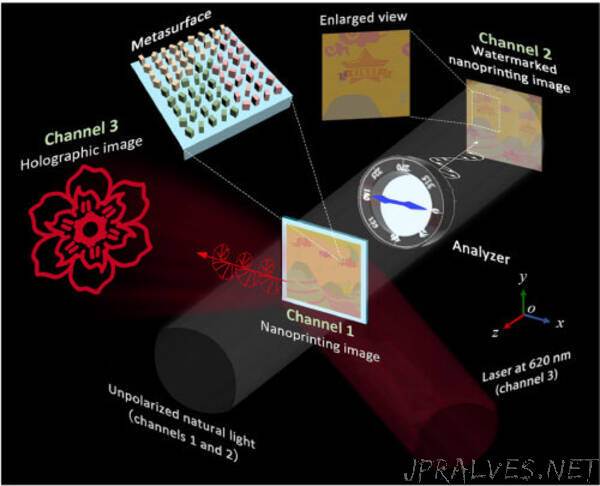
“New technology could offer a double safeguard to guard against counterfeiting
Researchers have developed a metasurface device that can display three types of images depending on the illumination light. The three-channel device could be used as an anticounterfeiting measure or offer a new way to securely deliver encrypted information.
“Metasurfaces are artificial materials with tiny nanostructures that can be used to manipulate light,” said research team member Qi Dai from Wuhan University in China. “In this work, we exploited both the size and orientation of the nanostructures to design a metasurface with three working modes.”
The researchers describe the new device in the Optica Publishing Group journal Optics Express. They also showed that depending on the light used, the metasurface would generate a holographic image or a structural-color nanoprinting image with or without polarization-dependent watermarks.
“Our tiny metasurface could be easily attached to currency, ID cards, credit cards, certificates, watches or rings for anticounterfeiting,” said Dai. “Because this multi-functional metasurface features twofold safeguards, it could provide a simple but effective approach to fight against counterfeiting.”
A three-in-one device
Although other metasurface-based anticounterfeiting devices have been developed, the hidden information is usually retrieved either on the surface or via a far-field holographic image. To create a more secure three-channel metasurface, the researchers merged watermarked structural-color nanoprinting with holographic imaging into a device, which is made of tiny nanobricks arranged on a transparent substrate.
By carefully engineering the sizes and orientations of the nanobricks, the researchers developed a way to create structural-color images that appear on the surface of the device as well as a holographic image that appears in the far-field. Instead of relying on inks or dyes, structural-color uses nanostructures with different geometric parameters to produce color by directly influencing the spectrum of transmitted or reflected light.
The unwatermarked structural-color nanoprinting image can be readily observed under natural light illumination while the same image covered with a watermark pattern can be decoded only with an optical polarizer. The holographic image in the third channel can only be viewed under coherent laser light.
Additional security
“When our metasurface is employed for anticounterfeiting, the unwatermarked structural-color nanoprinting could be easily observed using a camera on a smartphone,” said Dai. “The watermarked pattern could encode information needed to provide authentication since it only appears with the help of an optical polarizer. The holographic image, which might be reconstructed with a laser pointer, could be used as a second layer of security.”
To demonstrate the new metasurface device, the researchers fabricated a sample using standard electron beam lithography. The watermarked and unwatermarked nanoprinting images were observed using an optical microscope while the holographic images were visualized using an optical path consisting of a continuum laser, iris, lens, the sample and an optical screen.
“Our experiments showed that the watermarked structural-color nanoprinting had high polarization sensitivity and created a clear visual with bright color effects,” said Dai. “We also found that the designed metasurface can create a holographic image over a broad wavelength range from 480 nm to about 650 nm.”
The researchers plan to combine their new multi-functional metasurfaces with other materials such as liquid crystal and black phosphorus to achieve dynamic and more versatile control of light. They also want to explore how the metasurfaces could be used for optical computing and biomedical sensing and are working on ways to mass produce the new material.
Paper: N. Zhao, Z. Li, G. Zhu, J. Li, L. Deng, Q. Dai, W. Zhang, Z. He, G. Zheng, “Tri-channel metasurface for watermarked structural-color nanoprinting and holographic imaging,” Opt. Express, 30, 21, 37554-37565 (2022).
DOI: https://doi.org/10.1364/OE.472789”
